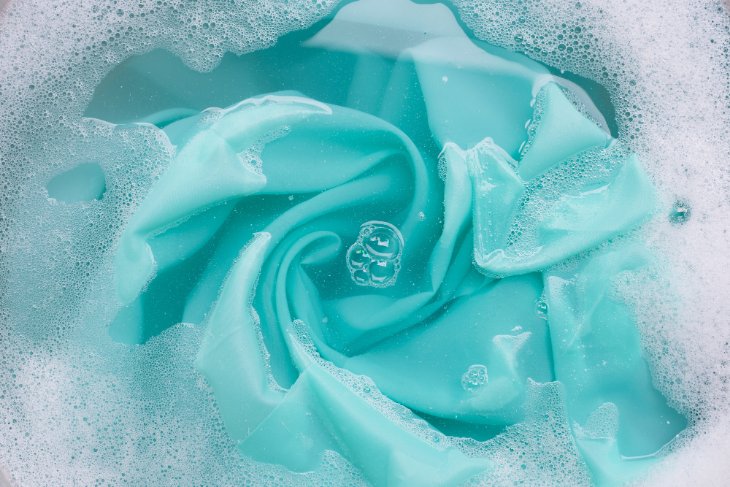Expert tips for washing, storing and maintaining delicate chiffon fabrics in children’s special occasion wear
Chiffon fabric brings an elegant, floaty quality to children’s special occasion wear. As a delicate lightweight material made from silk, nylon, or polyester, it needs special attention to maintain its beauty, especially when used in children’s clothing that faces additional challenges from play, food spills, and frequent washing. I’ve worked with children’s chiffon garments for many years and can share the best ways to keep them looking pristine for hand-me-downs or keepsakes.
The best way to care for children’s chiffon clothing is to hand wash it in lukewarm water with mild detergents like Ecover Delicate or Persil Silk & Wool, air dry it flat, and iron on low heat while slightly damp. This gentle approach helps preserve the fabric’s delicate weave and prevents damage to its sheer texture. When storing children’s chiffon pieces, I recommend keeping them in a cool, dry place away from direct sunlight, which is especially important in homes that may experience dampness.
Proper maintenance of chiffon ensures your children’s special occasion garments stay beautiful for years to come. While it may require extra care compared to sturdier play clothes, the results are worth the effort to keep these special items looking their best for family photos, hand-me-downs, or precious keepsakes.
On This Page
Key Takeaways
- Handle children’s chiffon garments gently and wash by hand in lukewarm water to preserve their delicate texture
- Always check garment care labels before cleaning as some items may require dry cleaning
- Use appropriate mild detergents like Fairy Non-Bio or Ecover for delicate fabrics
- Store chiffon items flat in a cool, dry place to prevent damage and maintain their shape
- Consider the climate when caring for chiffon, especially during damp winter months
Understanding Chiffon in Children’s Clothing
Chiffon is a lightweight and sheer fabric that I consider one of the most elegant materials in children’s special occasion wear. Its distinctive crinkled texture comes from the tightly twisted yarns used in its creation, making it perfect for flower girl dresses, party frocks, and special celebration outfits.
I’ve found that chiffon comes in several varieties commonly used in children’s fashion. The most common types include:
- Silk chiffon (most luxurious, often found in high-end children’s boutiques like Rachel Riley or Childrensalon)
- Polyester chiffon (most affordable and durable for children’s wear, widely available at Marks & Spencer and John Lewis)
- Nylon chiffon (practical for children’s clothing due to its resilience)
- Rayon chiffon (less common in children’s wear but occasionally used in party dresses)
This versatile fabric appears in many children’s clothing items, from flower girl dresses to special occasion blouses. I particularly appreciate its flowing nature and how it creates movement when children twirl or dance.
The price of chiffon for children’s clothing varies based on its composition. I’ve seen that polyester chiffon costs £4-8 per yard in fabric shops like John Lewis and Hobbycraft, while silk versions range from £12-24 per yard at specialty stores such as Liberty London.
One characteristic I always note is chiffon’s delicate nature. The fabric can snag easily, especially with active children, so it needs careful handling. Its sheer quality means it’s often used in layered designs to create depth and movement in children’s party dresses.
When shopping for children’s chiffon garments, I check for even weaving and smooth texture. Quality chiffon should feel soft to touch and have a subtle sheen without any obvious flaws or snags. UK retailers like Next and Monsoon typically offer good quality chiffon in their children’s special occasion collections.
Pre-Wash Instructions for Children’s Chiffon Clothing

Taking proper steps before washing children’s chiffon can protect the fabric and make cleaning more effective. The right preparation helps preserve the delicate fibres and ensures the best results, especially important for preserving special occasion garments that may become family heirlooms.
Check the Care Label
I recommend checking the care label before washing children’s chiffon garments as it provides vital washing instructions. Some chiffon items are dry clean only, though this is less common in children’s wear.
Look for specific temperature settings and washing methods listed on the label. If there’s no label, I suggest treating the fabric as delicate. For parents, it’s worth noting that children’s clothing labels must comply with strict EU textile labelling regulations, even post-Brexit, so the information should be reliable.
Write down the care instructions if the label is faded or likely to come off in the wash. This helps track the proper care method for future cleaning, especially important for special occasion dresses that may be worn infrequently.
Pre-Treat Stains on Children’s Chiffon
Children are prone to stains from food, grass, and art supplies. I always address stains before washing the entire garment. Dab the stained area gently with a clean white cloth – never rub as this can damage the fabric.
I recommend mild stain removers designed for delicate fabrics, such as Vanish Oxi Action for Delicates or Ecover Stain Remover, which are widely available at Boots, Sainsbury’s and Tesco. Apply these to stains using soft, gentle motions.
Mix a small amount of mild detergent with cool water. Apply this solution to the stain using soft, gentle motions. UK brands like Fairy Non-Bio or Persil Silk & Wool work well for children’s delicate fabrics.
For tough stains on children’s chiffon items, I use a specialised fabric stain remover made for delicate materials. Test it on a hidden area first to ensure it won’t damage the chiffon.
Let any pre-treatment solution sit for 5-10 minutes, but don’t let it dry completely on the fabric.
Washing Children’s Chiffon Garments
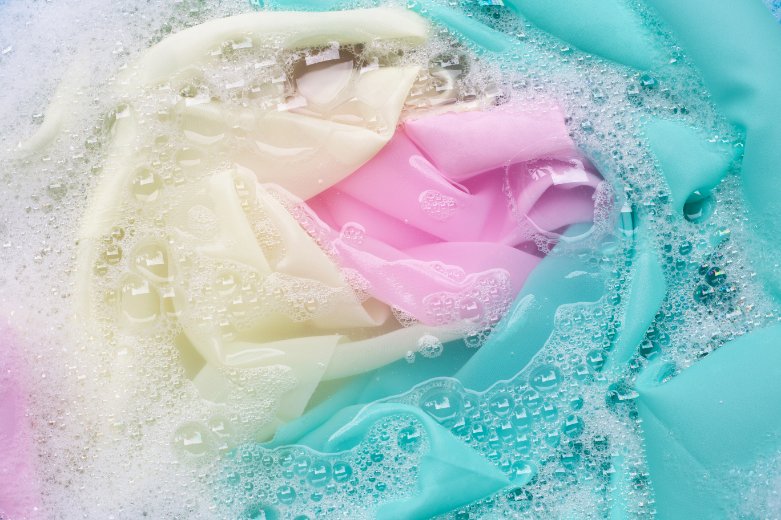
Chiffon fabric in children’s clothing needs careful cleaning to maintain its delicate texture and shape. I will show you two effective methods to clean your child’s chiffon garments properly, considering the challenges of the UK’s hard water areas.
Hand Washing Children’s Chiffon
I recommend using lukewarm water and a mild detergent designed for delicate fabrics. Fill a clean basin with lukewarm water and add a small amount of gentle soap. Parents should consider water hardness in their region – for hard water areas common in East Anglia and the South East, using filtered water or adding a water softener like Calgon can help protect delicate fabrics.
Gently submerge the chiffon and swish it around softly. Do not rub, twist or wring the fabric, especially important with children’s garments that may have embellishments or decorative elements.
Let the garment soak for 5-10 minutes.
Rinse thoroughly with cool water until all soap residue is gone. If your home has hard water, consider a final rinse with filtered water to prevent mineral deposits that can make fabric stiff and dull.
Press gently between clean towels to remove excess water. Never squeeze or wring the fabric.
Machine Washing Children’s Chiffon
While hand washing is preferable, busy parents sometimes need quicker options. I always place children’s chiffon items in a mesh laundry bag to protect them from snags and tears. These are readily available at retailers like Lakeland, Robert Dyas, and Wilko.
Select the delicate cycle and cold water setting. Use the minimum amount of mild detergent needed – options like Ecover Delicate, Fairy Non-Bio or Persil Silk & Wool are excellent choices.
Never mix chiffon with heavy items like jeans or towels. Pair with other lightweight delicates only.
Remove items promptly when the cycle ends to prevent wrinkles, which are especially noticeable in children’s chiffon party dresses.
Important tip: Check the care label first – some chiffon items are dry clean only, though this is less common for children’s everyday chiffon garments.
Avoid using fabric softeners as they can damage the delicate fibres. Instead, parents might consider adding a small amount of white vinegar to the final rinse, which naturally softens fabrics without leaving residue – particularly important if your child has sensitive skin.
Drying Children’s Chiffon Correctly
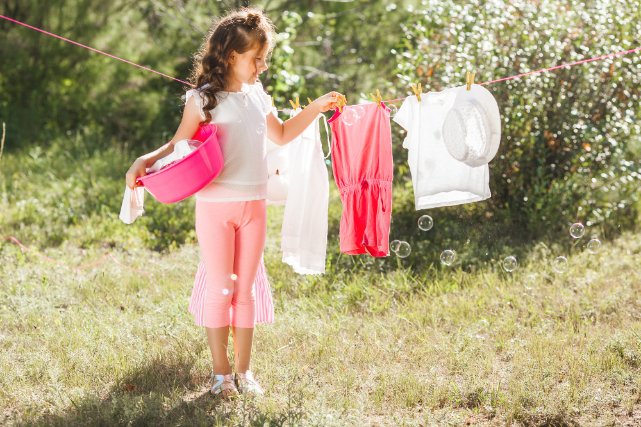
Proper drying techniques are essential to maintain chiffon’s delicate texture and prevent damage. I find that gentle handling and patience are key to success, especially with children’s special occasion wear that you want to preserve.
Removing Excess Water
I never wring or twist wet chiffon garments, as this can permanently distort the fabric’s shape. Instead, I gently press the garment between clean, dry towels to remove excess moisture.
I place the child’s chiffon item flat on a white towel, then layer another towel on top. Next, I apply light pressure by pressing down with my palms.
I repeat this process with fresh towels if needed until most of the water is absorbed. It’s crucial to avoid rubbing the fabric, as this can cause stretching or pilling, particularly in children’s delicate party clothes.
Air Drying Children’s Chiffon
I always air dry chiffon away from direct sunlight, as heat and UV rays can weaken the fibres and cause fading. This is especially important in conservatories or sunrooms which can magnify heat.
The best method is to lay the garment flat on a clean, dry white towel. I smooth out any wrinkles gently with my hands. For homes dealing with winter dampness, ensure good ventilation or use a dehumidifier in the room where garments are drying to prevent musty odours.
I never use clothes pegs or hangers while the fabric is wet, as they can leave marks or cause stretching. Instead, I ensure the item lies completely flat until thoroughly dry. This is particularly important for children’s dresses with fuller skirts or decorative elements.
For optimal results, I choose a well-ventilated room with moderate temperature. This helps prevent mustiness and ensures even drying, a particular concern in older properties that may have damp issues during winter months.
Ironing Children’s Chiffon Clothes
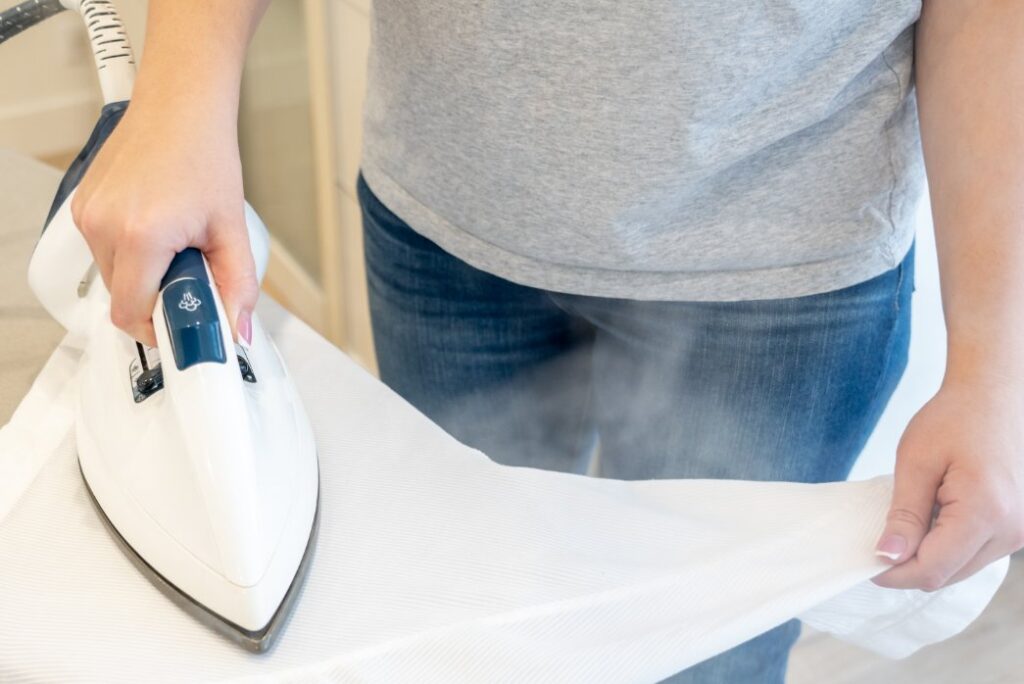
I recommend setting your iron to the lowest heat setting when working with children’s chiffon garments. This delicate fabric can melt or scorch easily from high temperatures, especially polyester chiffon commonly used in children’s clothing.
I always use a pressing cloth between the iron and chiffon to protect the fabric. A clean white cotton cloth or thin towel works well as a pressing cloth. This is particularly important for children’s special occasion garments that may have decorative elements or embellishments.
How to Get Wrinkles Out of Chiffon Without a Steamer
If you don’t have a steamer, don’t worry. Before ironing, I lightly dampen the chiffon using a clean spray bottle filled with distilled water. For homes in hard water areas like London and the Southeast, using filtered or distilled water prevents mineral deposits that can leave spots on delicate fabrics.
Alternatively, hang the chiffon garment in the bathroom while you shower. The steam will help release minor wrinkles naturally without direct heat. This gentle method is perfect for children’s delicate party dresses that need refreshing between wears.
You can also try the damp cloth method: Place a slightly damp white cotton cloth over the chiffon and iron on a low setting. The moisture from the cloth creates steam that removes wrinkles while protecting the fabric.
I always turn children’s chiffon garments inside out before ironing. This prevents any shine marks from appearing on the right side of the fabric and protects decorative elements.
Essential Ironing Tips for Children’s Chiffon:
- Keep the iron moving constantly
- Never leave it sitting in one spot
- Press gently rather than pushing down hard
- Work in small sections at a time
- For children’s layered chiffon dresses, iron each layer separately
Is It Better to Iron or Steam Chiffon?
Steaming is generally preferable for children’s chiffon garments as it’s gentler on the fabric and reduces the risk of damage. Retailers like John Lewis, Argos, and Lakeland offer affordable handheld steamers perfect for delicate fabrics.
Steaming works particularly well for children’s multi-layered chiffon garments like flower girl dresses where traditional ironing might be challenging. Hold the steamer about 10cm away from the fabric and work from top to bottom.
However, for stubborn wrinkles, a combination approach works best: first steam to relax the fibres, then carefully iron with a pressing cloth if necessary.
Does Chiffon Need to Be Steamed?
While not absolutely necessary, steaming is highly recommended for children’s chiffon garments. It’s safer than ironing and effectively removes wrinkles without direct contact. This is especially important for embellished chiffon garments common in children’s special occasion wear.
If you don’t have a steamer, the bathroom shower method or damp cloth technique described above can work as alternatives. In homes with good water pressure, the shower steam method is particularly effective.
For minor wrinkles in children’s chiffon, simply hanging the garment on a padded hanger in a bathroom during a hot shower can be sufficient. The natural steam will help the fabric relax, making this a practical option for busy parents.
I find it best to iron chiffon while it’s slightly damp. If the garment is dry, I use the steam setting on my iron or mist it lightly with water first. Always check the care label before ironing any child’s chiffon item. Some chiffon fabrics may need even lower temperatures or might not be suitable for ironing at all.
Storing Children’s Chiffon Garments
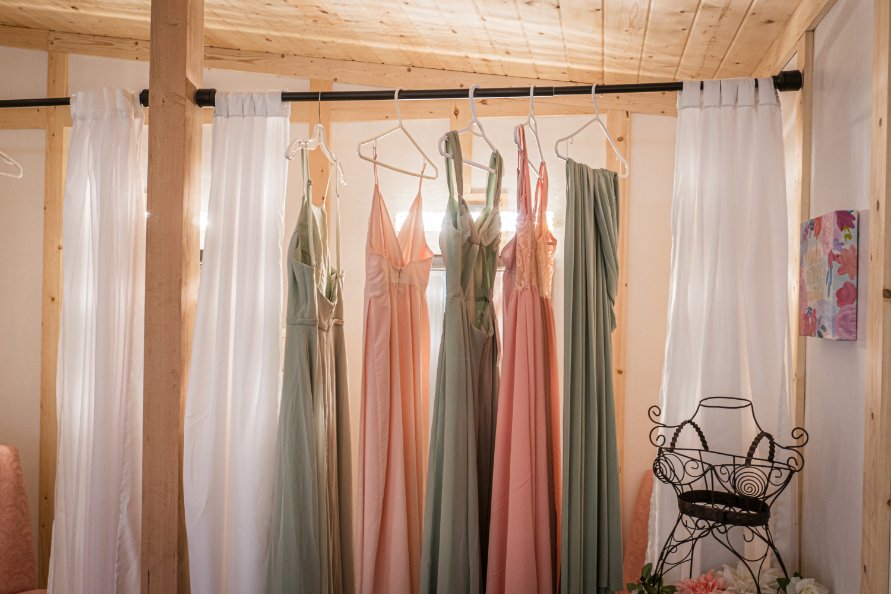
I recommend keeping children’s chiffon garments in a cool, dry place away from direct sunlight to prevent fading and fabric damage. This applies to all chiffon items like dresses, blouses and special occasion wear. In homes, which can sometimes suffer from dampness issues, ensure wardrobes are well-ventilated and consider using dehumidifiers in particularly humid areas.
Never use wire hangers for children’s chiffon clothing. I suggest using padded hangers or small-sized children’s hangers with padding to maintain the garment’s shape. For very delicate pieces like flower girl dresses or party frocks, rolling them in acid-free tissue paper helps prevent creasing.
Make sure your child’s chiffon items are completely clean and dry before storage. Even small amounts of moisture can lead to mildew or fabric deterioration, particularly in the UK’s often damp climate. Check for food stains, which are common on children’s garments – even invisible juice spills can oxidize over time.
For special occasion dresses, I recommend using breathable cotton garment bags rather than plastic covers. Retailers like John Lewis, Lakeland and The White Company offer suitable options. This protects from dust while allowing air circulation.
How to Keep Chiffon from Wrinkling
To minimise wrinkles in stored children’s chiffon garments, I recommend the following:
- Use tissue paper between folds to prevent sharp creases
- Store flat in drawers rather than hanging when possible
- If hanging, use appropriate sized padded hangers
- Don’t overcrowd wardrobes – give chiffon items space
- For long-term storage of special occasion dresses, use acid-free tissue and cloth storage boxes
For families living in period properties with limited storage, consider vacuum storage bags with caution – they work well for short-term storage but can create deep creases in chiffon if used long-term.
Storage tips for children’s chiffon:
- Keep away from harsh lighting
- Use moth repellent sachets (lavender or cedar work well and are child-friendly)
- Avoid overcrowding in wardrobes
- Store folded items flat in drawers
- Place acid-free tissue paper between folds
- Consider seasonal humidity changes when choosing storage locations
How Long Does Chiffon Fabric Last?
With proper care, children’s chiffon garments can last for decades, becoming cherished heirlooms. Polyester chiffon (most common in children’s wear) is particularly durable and can maintain its appearance for 5-10 years with regular wear and proper care. Silk chiffon requires more careful handling but can last even longer as a preserved keepsake.
The longevity of chiffon depends significantly on storage conditions. In the UK’s varying climate, protecting garments from humidity and temperature fluctuations is essential. Using silica gel sachets in storage containers helps absorb excess moisture, particularly important during wet British winters.
Regular refolding of stored chiffon pieces every few months prevents permanent crease lines from forming. I find this especially important for children’s special occasion dresses that might be kept as keepsakes or hand-me-downs.
Spot Cleaning and Stain Removal for Children’s Chiffon
Children are particularly prone to staining their special occasion wear with food, drinks, grass, and art supplies. Before treating any stains on children’s chiffon, I recommend identifying the type of stain first, as different stains need different cleaning methods.
I always test cleaning solutions on a hidden area first to check for any fabric damage or discolouration. This is especially important with delicate chiffon in children’s special garments.
For fresh stains common at children’s parties (like juice, chocolate, or ice cream), I gently blot the area with a clean white cloth. I never rub the fabric as this can spread the stain and damage the delicate fibres.
For water stains, I find that using a handheld steamer works brilliantly to lift the marks without damaging the material. Affordable steamers are available at retailers like Argos, Currys, and John Lewis.
If the label says “dry clean only”, I take it straight to a professional. This is particularly important for silk chiffon garments. Chains like Johnson Cleaners or Timpson offer specialist cleaning services for delicate fabrics.
Important Tips for Removing Children’s Stains from Chiffon:
- Never mix cleaning products
- Work from the outside of the stain towards the centre
- Use gentle dabbing motions
- Avoid harsh chemicals
- Keep the fabric flat while treating stains
- Environmentally friendly options like Ecover stain remover work well on children’s garments
For stubborn chocolate or ice cream stains (common at children’s parties), make a solution of mild detergent like Fairy Non-Bio and cool water. Dab gently, then rinse by pressing a clean damp cloth against the area. Repeat until the stain lifts.
I recommend storing children’s chiffon items in a cool, dry place after cleaning to prevent new stains and maintain the fabric’s quality.
Professional Care for Children’s Chiffon

Professional care methods help preserve chiffon’s delicate texture and extend its lifespan. I recommend dry cleaning as the safest option for maintaining this elegant fabric, especially for treasured items like flower girl dresses that you might want to preserve as keepsakes.
Dry Cleaning Children’s Chiffon
Professional dry cleaning is the most reliable way to clean children’s formal chiffon garments without damaging their delicate fibres. I find that dry cleaners use special solvents that remove dirt and stains effectively while protecting the fabric’s structure. Reputable chains like Johnsons Cleaners, Timpson, and Jeeves of Belgravia specialize in handling delicate fabrics.
I always tell my dry cleaner when a garment is made of chiffon and intended for a child, as they’ll need to handle it with extra care, particularly around seams and hems. Many UK dry cleaners offer specialist services for wedding and party attire, including children’s formal wear.
I avoid home dry cleaning kits for children’s chiffon items. These products can be too harsh and might damage the fabric’s delicate weave.
If you have embellished or heavily decorated children’s chiffon pieces, professional dry cleaning is especially important. The professional process helps prevent beading, sequins, or embroidery from becoming loose or damaged. For families with heirloom or expensive children’s formal wear, specialist cleaners like Jeeves of Belgravia offer preservation services.
I make sure to remove any brooches, pins or removable decorations before sending children’s chiffon to the dry cleaners, as these can snag or tear the fabric during cleaning.
Tips for Maintaining Children’s Chiffon Quality
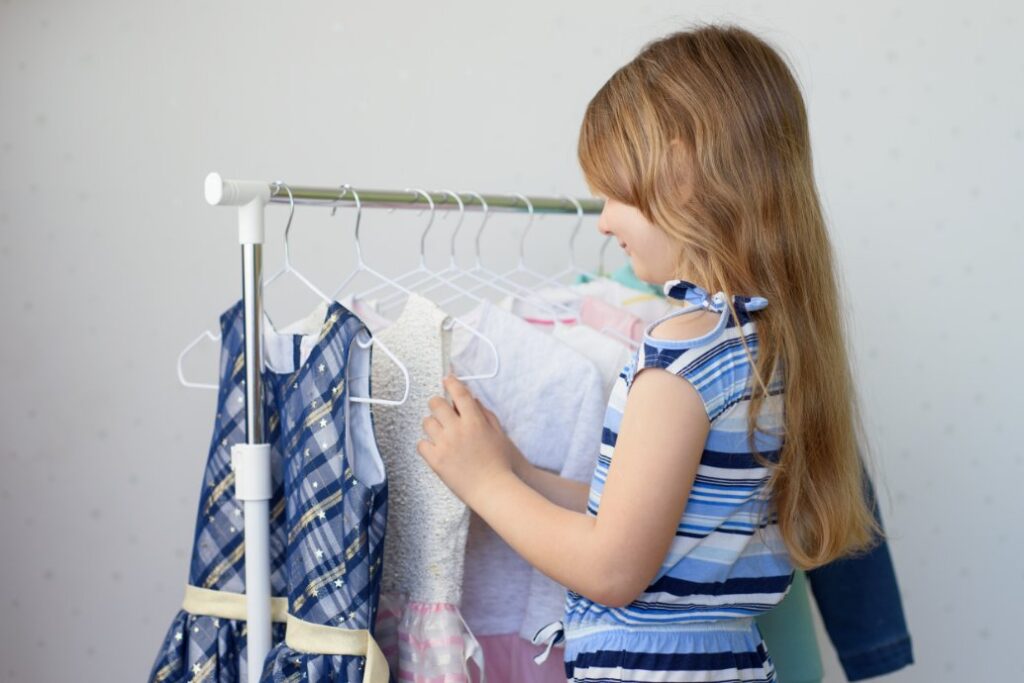
I recommend storing children’s chiffon garments in breathable cotton garment bags to protect them from dust and snags. Never hang children’s chiffon on wire hangers – small padded hangers are much gentler on the fabric and properly sized for children’s clothing. Retailers like John Lewis and Marks & Spencer offer children-sized padded hangers.
Does Chiffon Shrink When Washed?
Polyester chiffon (most common in children’s wear) generally doesn’t shrink when washed correctly. However, silk chiffon can shrink if exposed to hot water or high dryer temperatures. Always follow care label instructions and use cool water for all chiffon types.
To prevent any potential shrinkage in children’s chiffon garments:
- Always use cold or lukewarm water (never hot)
- Avoid tumble drying completely
- Don’t wring or twist the fabric when wet
- Lay flat to dry naturally
- Keep away from direct heat sources
In the hard water areas, using water softeners can help maintain fabric quality and prevent mineral buildup that might affect the fabric’s hand and drape.
When washing children’s chiffon, I always use a mesh laundry bag and cold water with mild detergent. This helps prevent damage from friction with other clothes.
I never wring or twist chiffon to remove water. Instead, I gently press it between clean towels to absorb moisture.
Key Storage Tips for Children’s Chiffon:
- Keep away from direct sunlight
- Store in cool, dry places
- Use breathable covers
- Avoid plastic bags
- Consider seasonal humidity when choosing storage locations
Is Chiffon Hot to Wear in Summer?
Chiffon is actually one of the most breathable and comfortable fabrics for children to wear in summer, making it perfect for UK summer weddings and garden parties. Its lightweight, sheer nature allows air to circulate, keeping children cool even during outdoor events.
Silk chiffon is the most breathable option, though polyester chiffon (more common in children’s wear) is also relatively cool. The loose drape of chiffon means it doesn’t cling to the skin, allowing for better air circulation.
Do You Sweat in Chiffon?
Chiffon is one of the better fabrics for reducing visible sweat marks, making it ideal for active children at special events. Its textured surface and often patterned or layered nature helps disguise any moisture. This is particularly beneficial for summer events, which can sometimes be unexpectedly warm.
For children who may be sensitive to synthetic fabrics, silk chiffon is the most breathable option, though it is more expensive and delicate. Polyester chiffon, while less breathable than silk, still performs better in warm weather than many other formal fabric options.
For parents concerned about children overheating at summer events, chiffon is an excellent choice compared to heavier formal fabrics like velvet, satin, or taffeta.
To prevent wrinkles, I lay chiffon flat to dry on a clean white towel. Never use the tumble dryer, as heat can damage the delicate fibres.
I always check the care label before washing. Some children’s chiffon items need dry cleaning only. If machine washing is allowed, I use the gentlest cycle available.
Important: I never iron chiffon directly. Instead, I use the steam setting on my iron and hold it slightly above the fabric. If needed, I place a white cotton cloth between the iron and chiffon.
Conclusion
Caring for chiffon in children’s clothing requires attention to detail and gentle handling, but the results are worth the effort. By following the guidelines in this comprehensive guide, parents can ensure their children’s special occasion wear remains beautiful for years to come, potentially becoming cherished keepsakes or hand-me-downs.
The key to successful chiffon care lies in understanding the fabric’s delicate nature while adapting care methods to suit the UK’s climate and water conditions. Using appropriate available products like Ecover Delicate or Persil Silk & Wool helps protect both the fabric and children’s sensitive skin.
Remember that proper storage is just as important as cleaning. The UK’s sometimes damp climate means extra attention should be paid to using breathable garment bags, acid-free tissue, and ensuring adequate ventilation in storage areas.
For busy parents, finding a balance between ideal care methods and practical solutions is important. While hand washing is preferable, careful machine washing using appropriate settings and protective mesh bags can be an acceptable alternative for many children’s chiffon items.
Final Recommendations:
- Always check care labels before cleaning any children’s chiffon garment
- Use appropriate gentle detergents designed for delicate fabrics
- Consider your local water hardness when washing chiffon at home
- Store special occasion items like flower girl dresses with acid-free tissue in breathable containers
- For treasured items, professional dry cleaning and proper preservation methods are worth the investment
- Remember that polyester chiffon (common in children’s wear) is more durable than silk, but still requires gentle handling
- Consider the UK’s seasonal humidity changes when choosing storage methods and locations
By treating children’s chiffon garments with appropriate care, these special pieces can remain beautiful despite the challenges of active wear, creating lasting memories of special occasions for years to come.
Frequently Asked Questions About Children’s Chiffon Care
Proper chiffon care for children’s garments requires specific methods for washing, drying, and maintaining this delicate fabric. I recommend gentle techniques and precise temperature control to prevent damage, especially important for special occasion wear.
What is the best method to wash a child’s chiffon dress?
I always use cold water and mild detergent for washing children’s chiffon dresses. Fill a basin with cool water and add a small amount of gentle soap like Ecover Delicate or Persil Silk & Wool.
Swish the dress gently without rubbing or wringing. Let it soak for 15-20 minutes.
Rinse thoroughly with cool water until all soap residue is gone. For UK homes in hard water areas, a final rinse with filtered water can help maintain fabric softness.
Can children’s chiffon be machine washed, or does it require hand washing?
Machine washing is possible if the care label permits it. I always use a mesh laundry bag to protect the fabric. These are readily available at UK retailers like Lakeland and John Lewis.
Select the gentle cycle and cold water setting. Add mild detergent only.
I never mix children’s chiffon with heavy items like jeans or towels. For families with busy schedules, setting aside a small separate delicates wash is more efficient than hand-washing individual items.
How should a child’s chiffon flower girl dress be cleaned?
I recommend professional dry cleaning for special occasion dresses like flower girl gowns. The intricate beading and delicate construction need special care. UK specialists like Jeeves of Belgravia offer services specifically for wedding attire.
If the label allows home cleaning, hand wash using cool water and minimal handling.
For families wanting to preserve flower girl dresses as keepsakes, professional cleaning followed by appropriate storage in acid-free tissue is worth the investment.
What are the steps for drying children’s chiffon garments properly?
Never wring or twist chiffon when wet. I gently squeeze out excess water.
Lay the garment flat on a clean white towel. Roll the towel to absorb moisture.
Reshape the garment and dry it flat away from direct sunlight and heat. During winter, ensure good ventilation to prevent mustiness.
Is it possible to remove water stains from a child’s chiffon dress?
I use gentle steam to tackle water stains. Hold the steamer several inches away from the fabric.
Test the steam on a hidden area first. Move the steamer continuously to prevent damage.
For stubborn stains, consult a professional cleaner. UK high streets typically have dry cleaners experienced with delicate fabrics.
Are there specific instructions for the care of polyester chiffon in children’s clothing?
Polyester chiffon is more durable than silk chiffon, making it ideal for children’s wear. I still use cool water and gentle detergent, with options including Fairy Non-Bio and Ecover.
Avoid fabric softeners as they can leave residue which may irritate children’s sensitive skin.
Air-dry flat or use the lowest dryer setting if the care label permits. The polyester content makes this type of chiffon more resilient to creasing than silk varieties.

